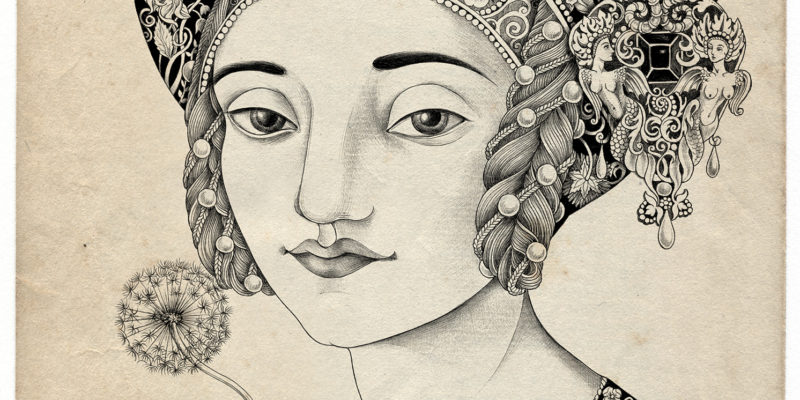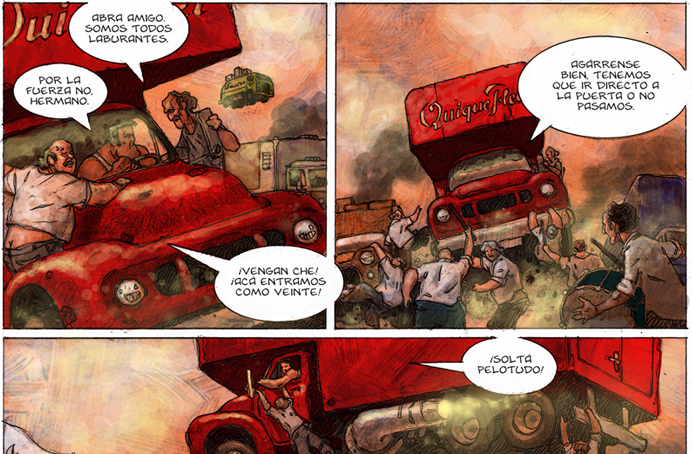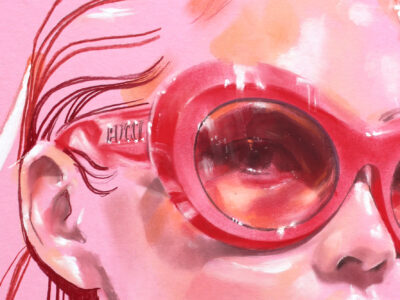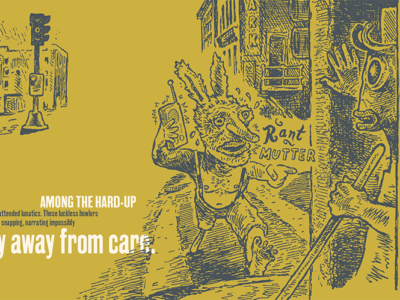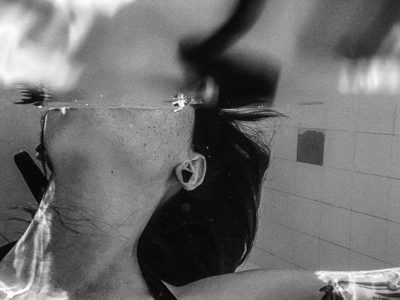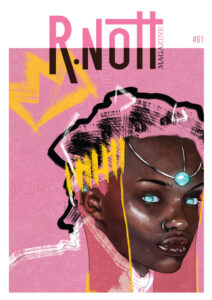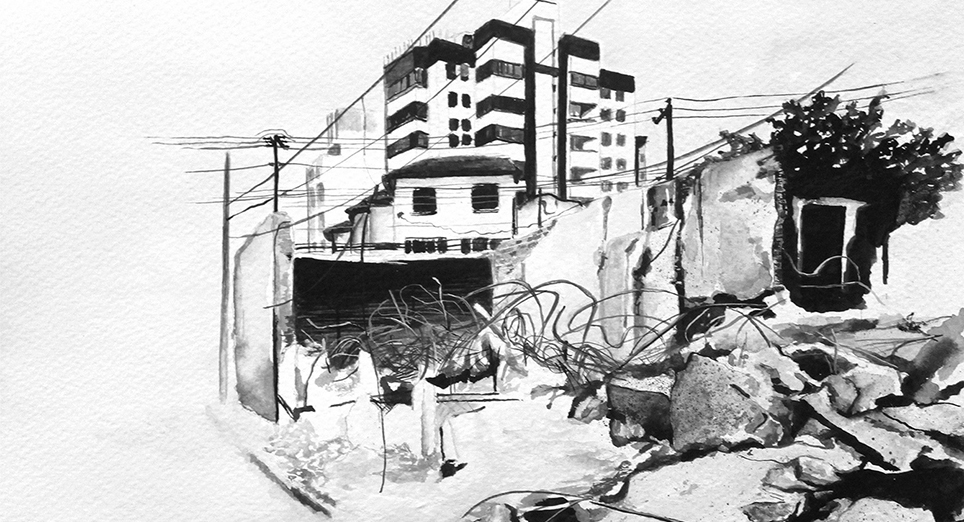Conheça Sveta Dorosheva, artista ucraniana radicada em Israel, e se apaixone, assim como nós, por suas ilustrações magistrais e sua simpatia. Entrevista exclusiva para a R.Nott Magazine.
“Agora, depois de cinco anos de esforço, não parece tão besta, mas naquele tempo argumentos como ‘Isso não é pra mim, eu acho que quero ilustrar livros’ soavam ridículos.”
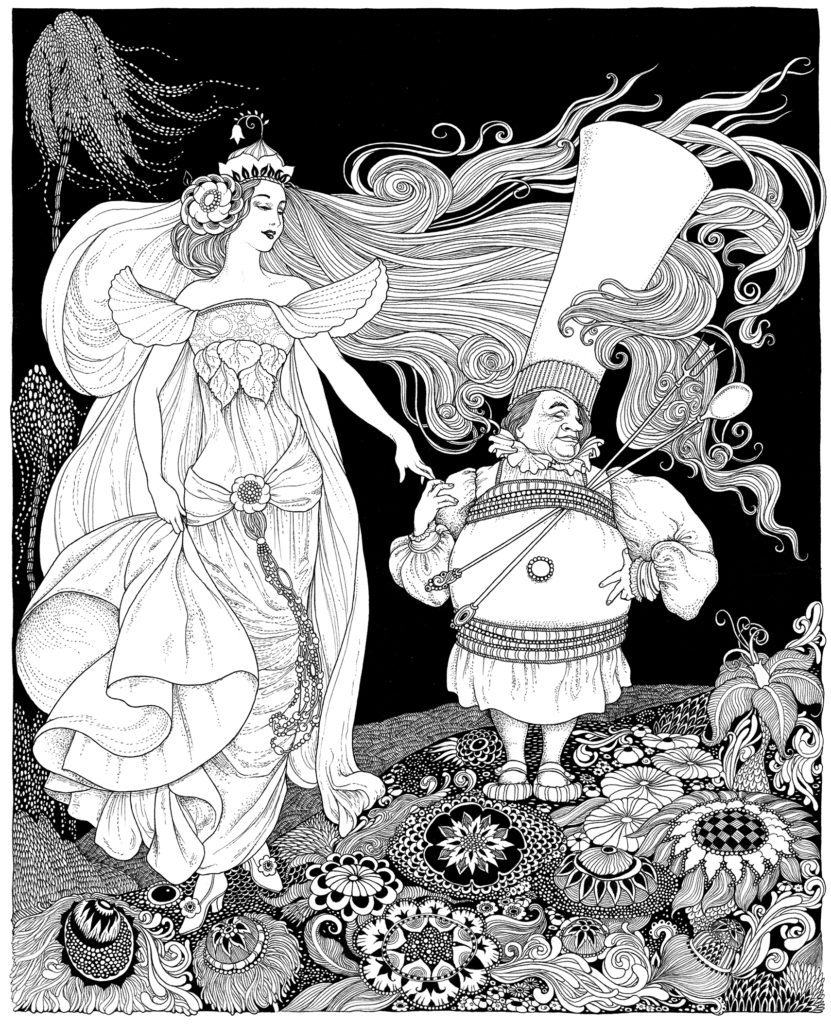
- Como vai, Sveta? Um prazer tê-la na revista!
Obrigada por me convidar!
- Como, onde, quando e por quê?
Eu venho de Zaporozhye, atualmente uma grande cidade industrial na Ucrânia, que naquele tempo ainda era parte da União Soviética. Eu pertenço a uma geração perdida entre duas épocas – nós ainda pegamos a cauda da decadência da era Soviética, mas os anos de formação caíram no tempo em que ‘não havia nada’, caos completo e desintegração de ideologias, países e mentalidades… Se você fosse um adolescente e não entendesse o que estava acontecendo, ninguém conseguiria te explicar, porque os adultos estavam confusos, deprimidos e desorientados. Dizem que a minha geração é muito flexível e independente, que pode aceitar qualquer mudança quase com indiferença. Não tenho certeza disso, mas a flexibilidade existe.
Quando terminei a escola, eu queria estudar arte, mas isso significava ter que ir embora para outra cidade e deixar a minha própria, e disso nem eu nem meus pais estávamos seguros na época, que eu seria capaz. Foi um tremendo engano, como descobri depois, mas eu não insisti e entrei na universidade local. Eu me formei em línguas e literatura. Foi aí que comecei a desenhar muito, porque os estudos eram muito, muito entediantes, e eu também acabei notando que quando desenho, consigo decorar coisas automaticamente. Até hoje, caso precise lembrar ou entender muito bem alguma coisa, eu apenas ligo o áudio enquanto desenho e isso se resolve sem esforço. Inclusive combinei com o meu marido de ele não repetir enredos de filmes enquanto estou desenhando…
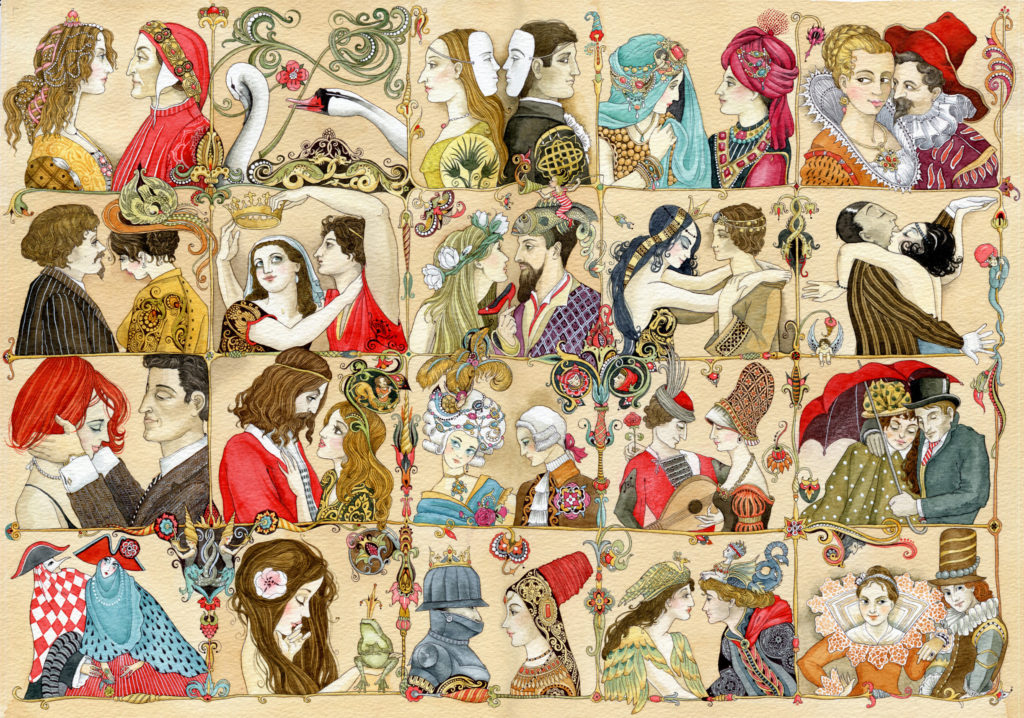
Depois de graduada, me ofereceram um trabalho de tradutora em Kiev. Nos anos seguintes eu trabalhei como intérprete, tradutora simultânea (pior trabalho da minha vida), assistente pessoal, jornalista, e designer de impressão. Eu continuei a desenhar ‘como um hobby’, mas percebi que desejava uma carreira ‘mais criativa’, então me mudei para a publicidade. Passei 7 anos em uma agência e trabalhei como designer, diretora de arte, e, finalmente, diretora de criação. E saí, no topo da minha carreira, para o nada.
É difícil explicar a qualquer um o porquê de você largar uma posição de alto gerenciamento, onde todo mundo te ama e quer te dar dinheiro e fama. Agora, depois de cinco anos de esforço, não parece tão besta, mas naquele tempo argumentos como “Isso não é pra mim, eu acho que quero ilustrar livros” soavam ridículos.
Além disso, enquanto eu maturava algumas decisões, a vida me deu uma ajuda – eu estava grávida do nosso segundo filho. Naquele tempo parecia que tudo na vida estava indo ‘pra outro lugar’, então eu decidi que não faria tanta diferença se nos mudássemos para outro país para estar mais perto da família e arranjar alguma ajuda com as crianças (meus pais se mudaram para Israel quando eu estava na universidade).
É mais fácil começar algo quando tudo é novo. Aqui eu comecei a descobrir o sonho de toda a vida que era fazer do desenho o meu trabalho. O que, com filhos pequenos, demora mais até que se desenvolva numa nova esfera. Mas, no fim das contas, estou muito feliz.
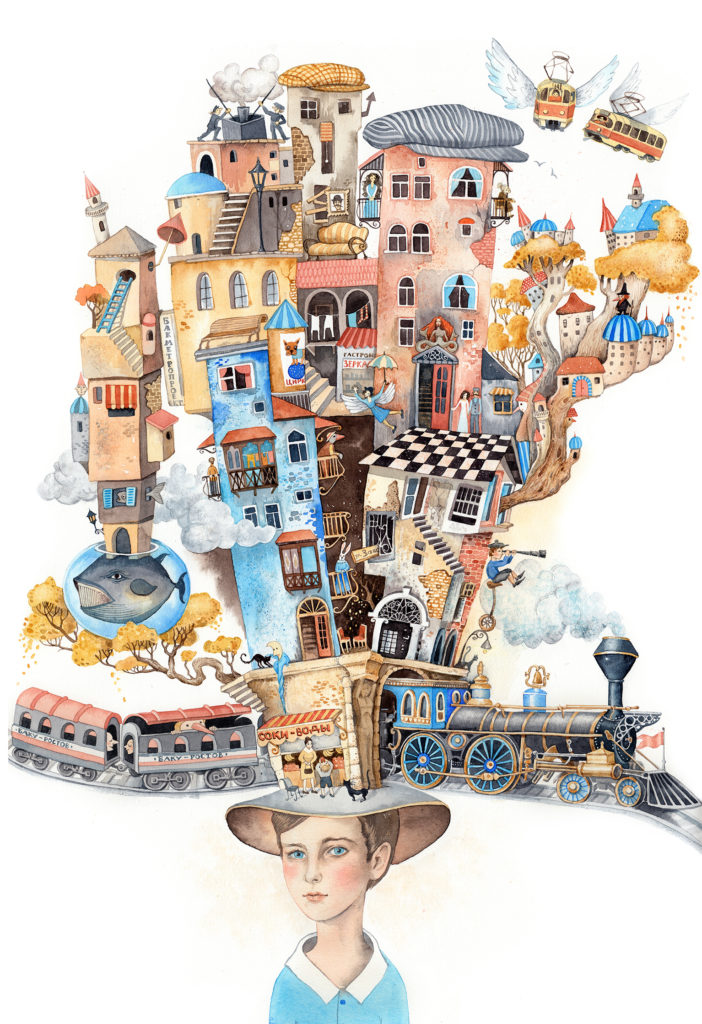
- Você é uma artista que carrega dentro de si dois mundos: Ucrânia e Israel. Como é para uma ucraniana produzir arte em Israel? Como esses dois mundos se mesclam no seu trabalho?
Como eu dizia, eu pertenço a uma geração que tem um problema com tradições – durante toda a minha juventude, tudo era um completo estrago, as mudanças estavam acontecendo permanentemente em todas as esferas da vida. Então eu não diria que carrego alguma genuína tradição ucraniana, muito menos judia. Além disso, não posso dizer que seja muito amarrada a Israel em termos de trabalho. Eu recebo encomendas do mundo inteiro, não estou trabalhando apenas para o mercado local. Até agora eu não faço ideia nem de como é o mercado editorial daqui. Mesmo assim, estou no momento ilustrando um livro ligado à literatura tradicional judia. É muito divertido e eu estou fazendo muita pesquisa a respeito da tradição judia e da cultura ao longo do trabalho (extremamente interessante!)
- O que você costuma ler? Existe algum texto que você sempre quis ilustrar e nunca teve oportunidade?
Para a minha tristeza, eu não tenho lido muito nos últimos anos. Eu trabalho de manhã, enquanto as crianças estão no jardim de infância e na escola. A partir do meio-dia estou com eles. Eu evito ler de noite por medo de cair no sono, já que depois que as crianças vão dormir eu tenho o meu segundo turno do meu precioso tempo de desenho. O único momento em que eu realmente leio é justo antes de dormir – lá pelas 3 da manhã. Raramente dura mais do que 10 minutos. Se eu me apego a um livro, isso arruína o meu trabalho, o que acontece de vez em quando, porque aí eu leio em vez de trabalhar nas minhas horas matinais…
E sim, há livro que eu sonho em ilustrar. Eu os chamo de ‘livros de aposentadoria’, o que quer dizer que quando eu esteja velha e grisalha e insone e banguela e com toneladas de tempo ao meu dispor, colocarei esses no topo da lista de prioridades (o que é um plano terrível, eu sei, mas até agora tudo bem). São eles: François Rabelais “Gargantua & Pantagruel”, os contos de fadas de E.T.A. Hoffmann (especialmente “O pote de ouro” e “O elixir do diabo”), e os contos de Gustav Meyrink, talvez o seu “Anjo da janela do Ocidente”. Eu vou começar com o Hoffmann.
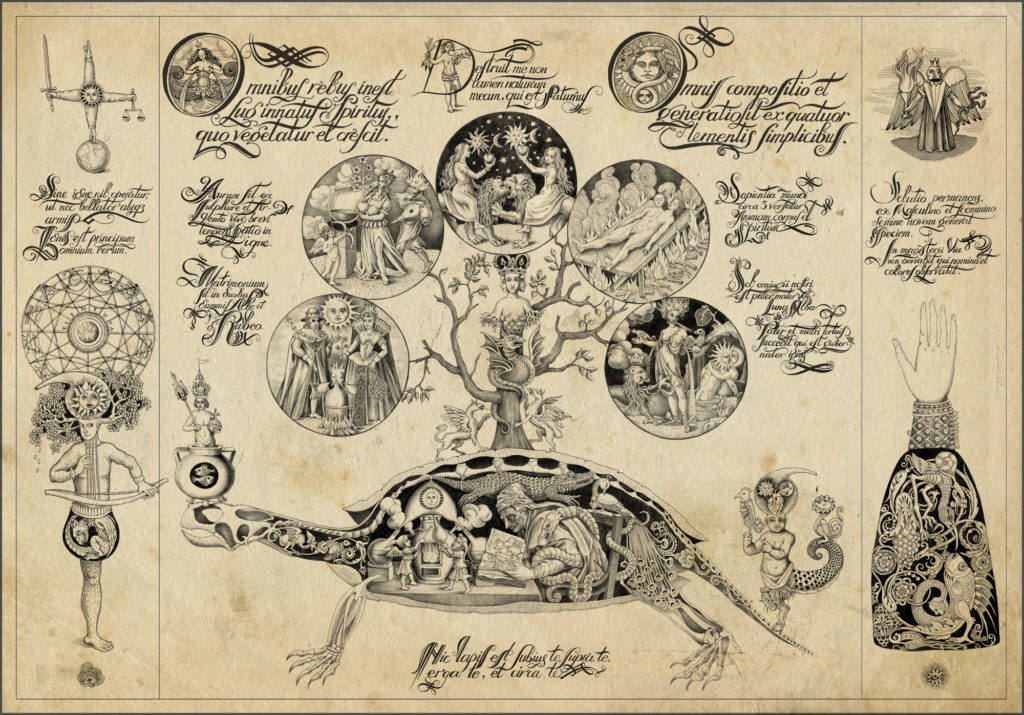
The Alchemyst
- Como você se sente sendo alguém que se graduou em literatura e de repente se vê como uma artista visual? Conte mais sobre esse período literário da sua vida.
Eu me sinto muito mal. Eu me arrependo desde aquele tempo da minha escolha de formação e continuo me arrependendo todos os dias. Eu sinto agudamente a falta de um treinamento acadêmico em arte, e tentei corrigir esse erro diversas vezes, mas um dia começou a ficar realmente estranha a coisa: todas as vezes em que eu planejei uma entrada atrasada em uma academia de artes, engravidei (sem brincadeira! A coincidência é quase assustadora – três tentativas – três filhos!). Eu ainda estou tentando arrumar as lacunas na minha formação – principalmente sendo autodidata (demorado, tedioso, frustrante), fazendo cursos de curta duração (melhores, mas insuficientes e superficiais), e aprendendo de outros artistas individualmente (precioso, mas difícil de conseguir).
Quanto ao período literário, eu tive um, mas não foi na universidade. Eu escrevi um livro há alguns anos (e o ilustrei). Se chama “The Nenuphar Book” e é escrito por criaturas mágicas a respeito de pessoas.
O livro tem vivido através do processo excruciante da crise dos livros impressos juntamente com a editorial, mas eu espero que um dia seja publicado. O ponto é que quando eu terminei de escrevê-lo e comecei a contatar os editores, eles em geral disseram que as ilustrações eram maravilhosas, mas, hum, o texto… Então comecei a pesquisar sobre escrita, li diversos livros a respeito disso, e descobri a literatura de toda uma nova perspectiva. Eu estava literalmente assombrada com quanto trabalho dava a tarefa de escrever. Eu era tão ingênua pensando que escrever era… bom, você só inventa algo e escreve lá. Ah, que estúpida. Então eu reescrevi a coisa toda, e mesmo que o livro nunca seja publicado, eu sou grata a essa experiência por me ensinar muito sobre literatura e escrita (muito mais do que na universidade, por sinal).
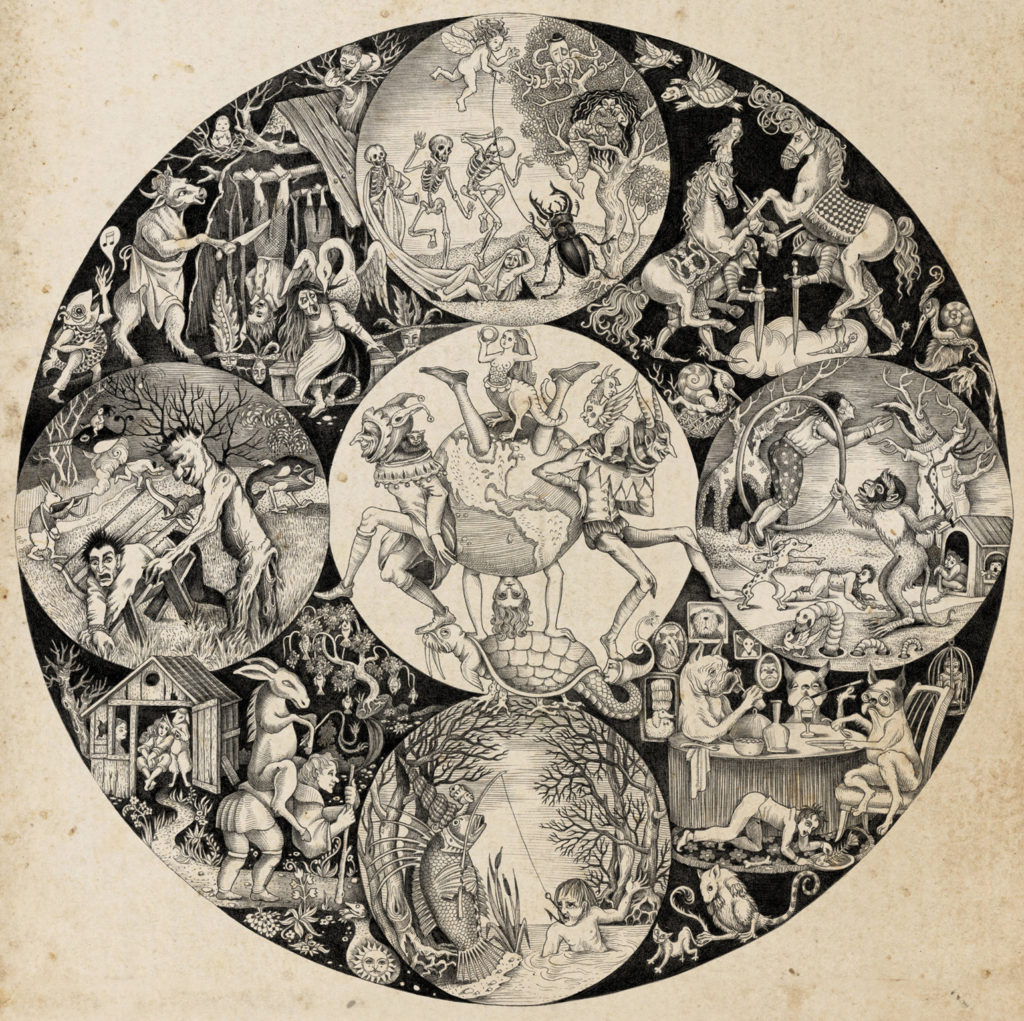
- Os seus filhos gostam dos seus desenhos? O que eles dizem sobre isso?
Ummm, não tenho certeza… As suas reações são tão diferentes. Eu geralmente acho que meu filho mais velho (9 anos de idade) é meio indiferente ao que faço. Ele parece ser um pouco frustrado por eu não ser uma desenhista de comics e não desenhe robôs e transformers e lutas, ou algo como ‘Mr. Giantpants Vs. Pinktentacle’. Ele também acha que desenhar mulheres peladas é nojento, e desenhar fadas e contos de fadas é infantil… Mas recentemente ele veio da escola e me contou uma história, cheia de sofrimento. Eles estavam cozinhando biscoitos da sorte na aula, e todos tinham que escrever um desejo secreto num pedaço de papel. “E eu escrevi ‘desejo que minha mãe vire a maior artista na terra’” – disse ele. – “E então eu estou comendo um biscoito e de repente sinto uma coisa estranha – eu cuspi, e era o pedaço de papel com o desejo sobre você. Então eu pensei um tempo e o engoli para que o desejo virasse realidade”. Então, acho que ele não é tão indiferente como eu pensava, e depois desse sacrifício, sabe… Estou destinada a virar a maior artista na terra, ele não me deixou escolha.
O meu outro filho (de 5 anos) é bastante interessado no que eu faço. Toda vez que ele vê meus desenhos, exclama “Sabe mamãe, você desenha muito bem!” com tamanha e genuína surpresa que você pensaria que ele apenas descobriu o fato de que eu desenho! Às vezes ele me pede para contar a história por trás do desenho, o que eu faço com prazer.
Meu filho mais novo (1 ano e meio) é a pessoa mais interessada no mundo quando o assunto são os meus desenhos, mas o seu interesse é perigoso. Ele deseja fortemente participar, e não se engana comigo, desenhando com ele – ele quer AQUELE pedaço de papel – aquele no qual eu estou trabalhando, aquele que está cuidadosamente guardado e seguramente empilhado bem longe dele.
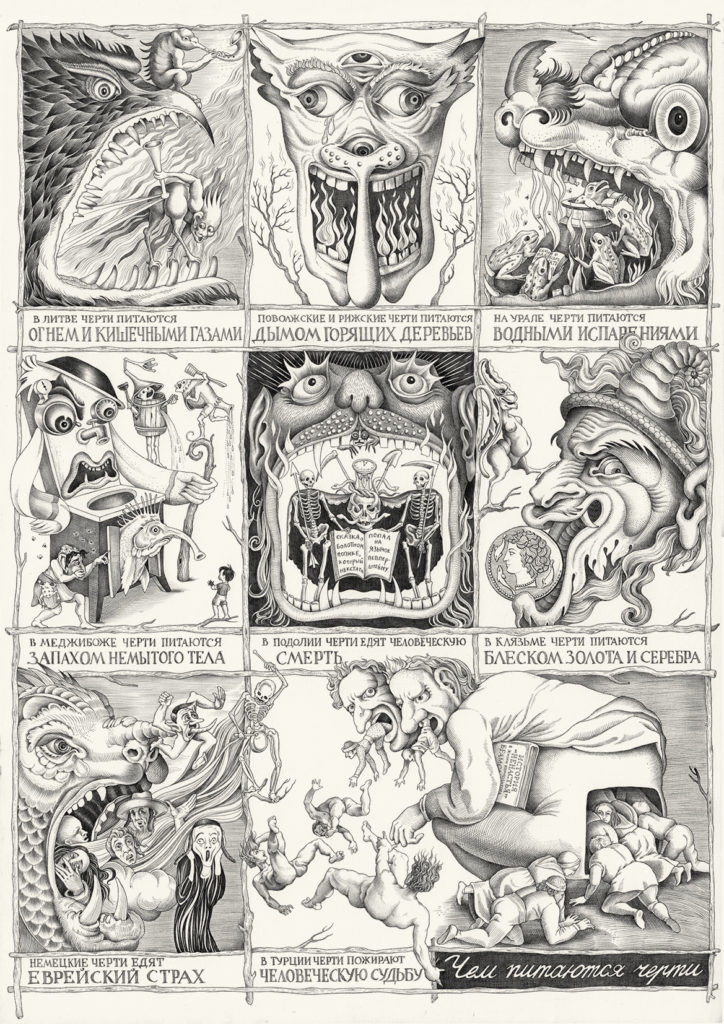
- Como você consegue mudar entre diferentes estilos? (Por exemplo, indo de The Alchemyst para Dancing Class). É uma coisa progressiva entre um e outro ou você consegue “mudar a chave” e simplesmente fazer diferente?
Pergunta interessante. Eu mesma já pensei várias vezes sobre isso. Você tem toda razão – eu posso sentir esses dois estilos ou ânimos vivendo em paralelo dentro de mim (eu os chamo ‘misterioso’ e ‘irreverente’). E eu troco entre eles quando estou cansada de um dos dois.
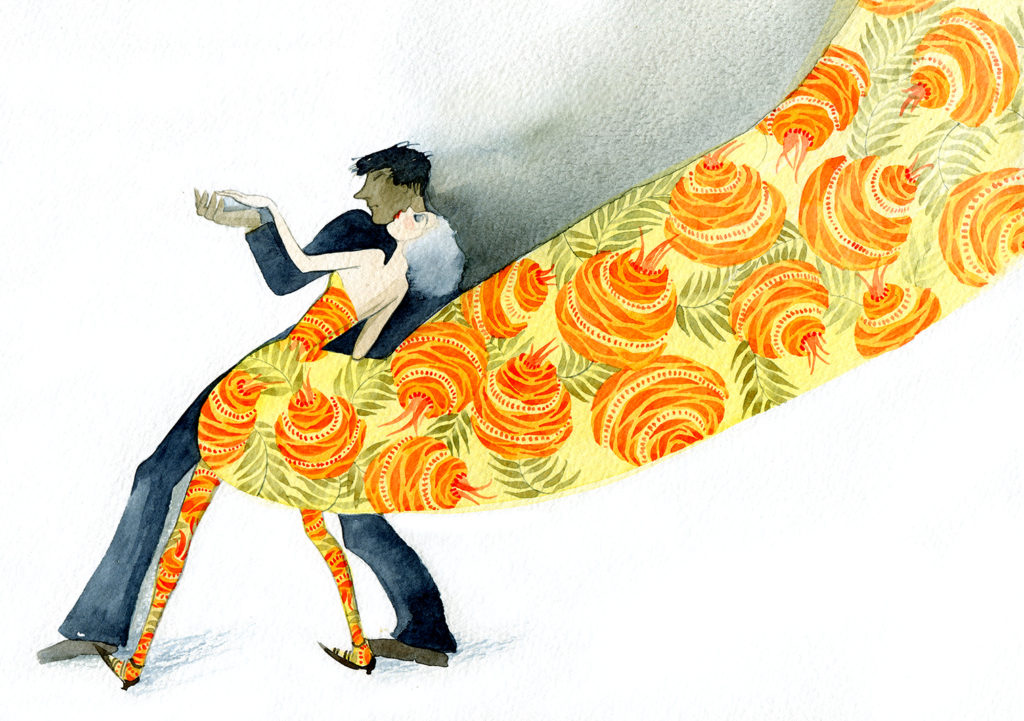
The Dancing Class
- Como é o seu processo de planejar a imagem? Todos os seus trabalhos são ricamente detalhados, mesmo entre tão diferentes estilos, então como você constrói a cena? Toma decisões no caminho ou pensa em tudo com antecedência?
Ambos. Geralmente eu tento pensar em tudo com antecedência, mas raramente acaba sendo como eu planejei. Exceto talvez na composição, todo o resto das decisões estão sujeitas a mudanças no processo.
Eu costumo começar com uma ideia escrita. Escrevo todas as ideias para essa ou aquela ilustração. Então faço alguns esboços para elas. Nesse estágio é claro o quê é melhor em termos de composição, ideia, e também as minhas obsessões pessoais (algumas coisas são mais interessantes de desenhar do que outras, e essas ‘obsessões’ são diferentes para cada artista). Então eu vou para o google imagens para buscar tudo na imagem que eu não sei como desenhar, ou para coletar referências. Ou contato o cliente para fotos de uma rua ou pessoa em particular, depende… Então faço um esboço detalhado, escaneio-o e uso a tela do meu computador como mesa de luz para transferi-lo à cópia final. Quando as coisas de saem bem, o esboço final já é a cópia limpa.
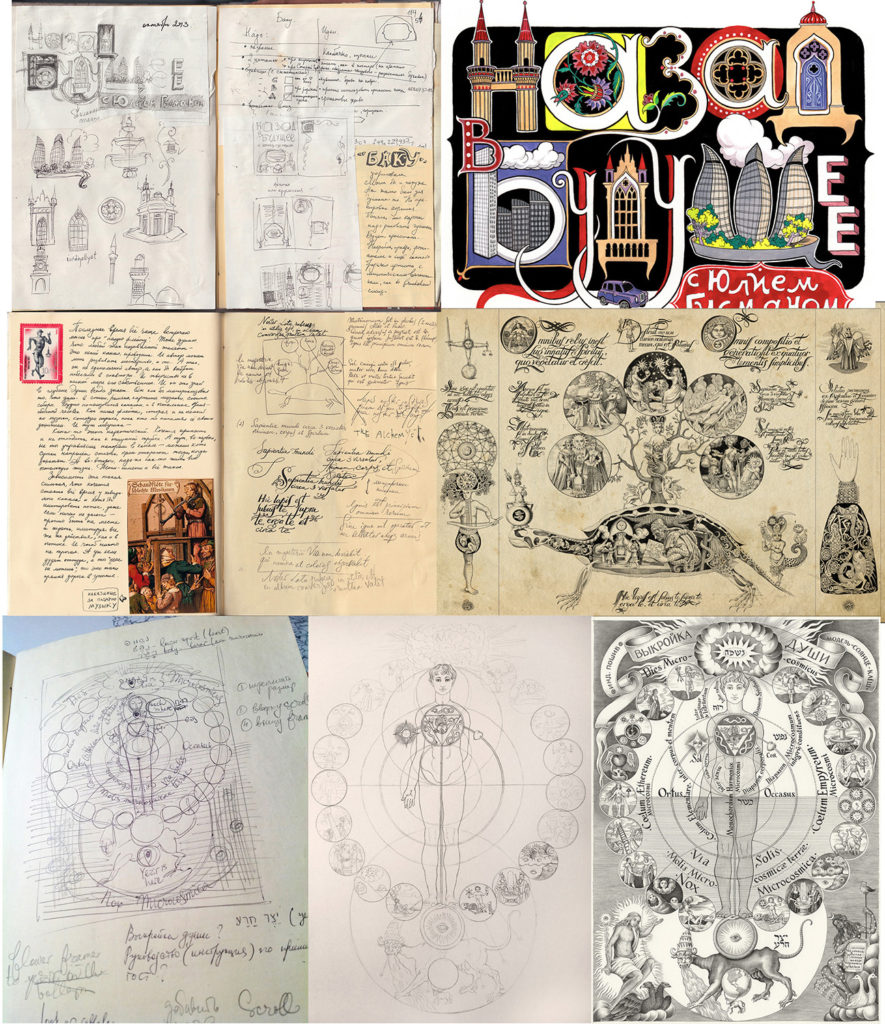
Progresso de ideias

- Quem são os seus personagens? De onde eles vêm?
A maioria vem de contos de fadas, mitos e weird science e crenças da idade média. Eu li muitos contos de fadas quando era criança. Depois escrevi minha tese sobre contos de fadas e mitologia quando estava na universidade. E muito depois, quando a internet rápida virou uma coisa comum, eu estava buscando por algo em uma das livrarias públicas online e me deparei acidentalmente com a emblemata medieval. E daí manuscritos iluminados. E daí bestiários. E daí tratados de alquimia. E daí… Eu não podia parar. Foi direto no coração, como encontrar o amor de sua vida. Eu ainda lembro desse primeiro encontro. Eu me sentia frágil, como um cristal moldado. E eu me lembro do meu primeiro desenho depois de ter descoberto esse novo mundo. Esses foram os melhores e mais completos dias da minha vida, embora para um observador pudesse parecer que ‘nada está acontecendo – essa pessoa passa seus dias quieta, taciturna, pensativa, caminhando longamente e se comportando como quem apenas agora recebeu notícias chocantes que influenciam toda a sua vida’.
- Grandes influências, heróis?
As grandes influências mudaram. Primeiro eu era influenciada por artistas da art nouveau e déco. Então me apaixonei pelos ilustradores da era de ouro (ainda sendo Edmund Dulac e Kay Nielsen os meus favoritos). E depois (agora) – idade média e inícios da renascença. Acabei de notar que as minhas influências vão no sentido contrário no tempo. Provavelmente eu irei esculpir petroglifos a seguir.
E sim, há heróis. Dürer é o meu superstar.
Eu mantenho também um Monte Olimpo pessoal, habitado pelos ilustradores de livros dos tempos modernos, os quais trato como celestes: Olga e Andrej Dugin, Kirill Chelushkin, Gennady Spirin, Lev Kaplan, Rebecca Dautremer, Lisbeth Zwerger, Shaun Tan… para nomear alguns. Na verdade eu acho que estamos vivendo na segunda ‘era de ouro’ da ilustração de livros, com ou sem crise editorial.
Ah sim, e há também o Codex Seraphinianus. Falando em heróis…
- No que você está trabalhando agora?
Meu atual grande projeto é ilustrar “Ferocious Holyman” – o livro de Dmitry Deitch (autor russo que vive também em Israel), que deriva da tradição judia – eu o mencionei antes.
É um texto tão rico em termos de ilustração, e é divertido e misterioso e complicado – tudo ao mesmo tempo. A maioria das minhas ‘obsessões’ estão ali – mito, fábula, fantasia, crenças, tradição, demônios, anjos e trapaceiros, humor, beleza, e coisas estranhas e maravilhosas.
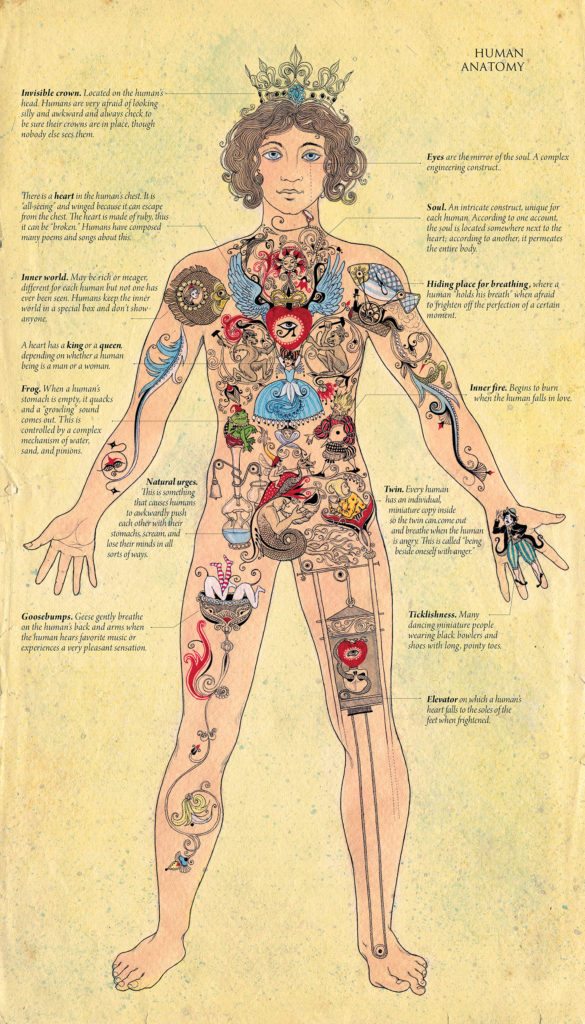
- Existe alguma pergunta que você sempre quis responder e nunca ninguém te perguntou?
Pergunta malandra! Em geral eu sou mais uma pessoa de perguntas que respostas. Mas sim, eu queria que alguém me perguntasse se eu gostaria de produzir alguma arte para um filme do Tim Burton, e fosse pra valer 🙂
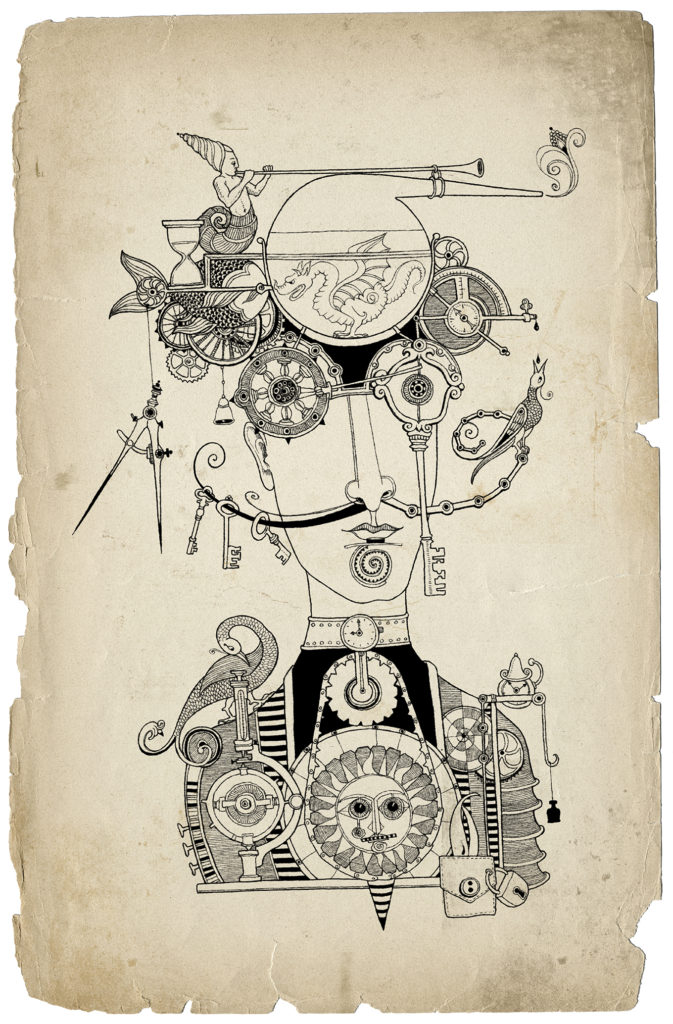
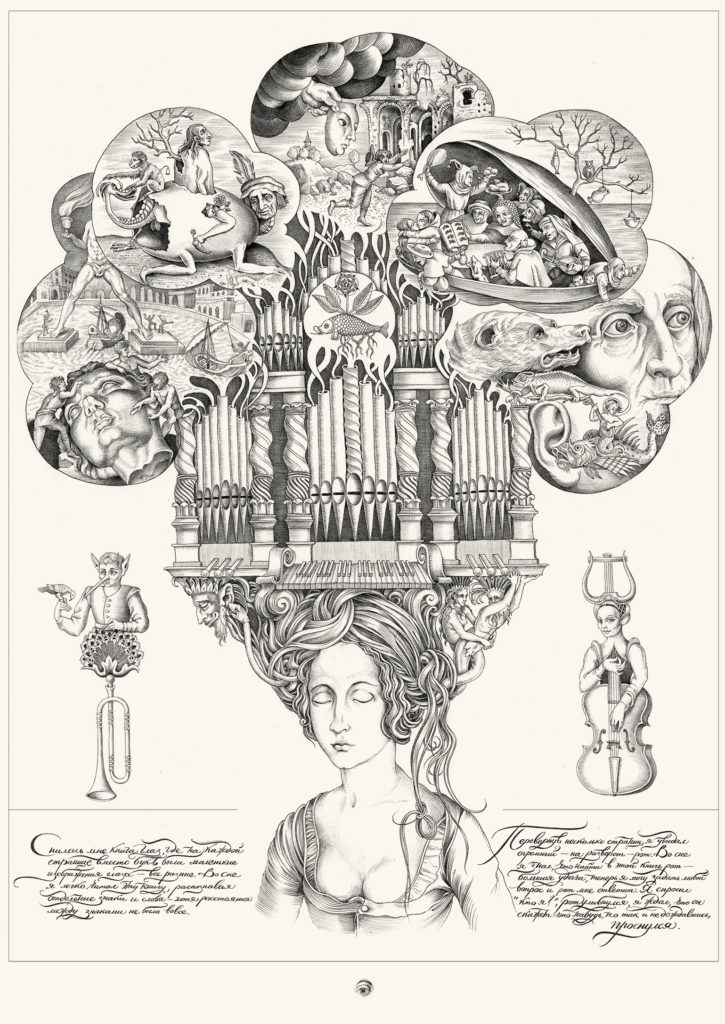
Site Oficial:
https://www.svetadorosheva.com/
English Version
- How are you, Sveta? Glad to have you in our Mag!
Thank you for inviting me!
- How, where, when, and why.
I come from Zaporozhye, currently a large industrial city in Ukraine, but at that time – part of the Soviet Union. I belong to the generation lost between two epochs – we’ve caught the tail of the decaying Soviet era, but the formation years fell on the time when ‘there was nothing’, complete chaos and disintegration of ideologies, countries and mentalities… If you were a teenager and didn’t understand what was happening, no one could explain it to you, because grown-ups were confused, depressed and disoriented. They say my generation is very flexible and independent, can accept any change almost indifferently. Not sure, but flexibility is there.
When I graduated school, I wanted to study art, but that meant going away to another city and leaving on my own, and neither my parents nor I were sure at that time, that I could do that. It was a hell of a mistake, as it turned out later, but I did not insist on going and entered the local university. I majored in languages and literature. That was when I started to draw a lot, because studies were very, very boring, and also I noticed that when I draw I remember things by heart automatically. Until this day, if I need to remember or understand something really well, I just put the audio on, while drawing and it settles down effortlessly. I made a point with my husband about not retelling me movies while I am drawing…
After I graduated I was offered a translator’s job in Kiev. The following years I worked as an interpreter, simultaneous translator (worst job of my life), personal assistant, journalist, and print designer. I continued to draw ‘as a hobby’, but thought I wanted a ‘more creative’ career, so I moved to advertising. I spent 7 years in a large network agency, and worked as a designer, art director and finally, creative director. And quit at the top of my career into ‘nowhere’.
It’s a hard time explaining to anyone why you quit from a top manager’s position, where everybody loves you and wants to give you money and fame. Now, after five years of effort, it wouldn’t look so lame, but at the time arguments like “This is not mine. I think I want to illustrate books” sounded ridiculous.
Also, while I was maturing to some decisions, life made them for me – I was pregnant with our second son. At that time, it seemed that the whole life was going ‘elsewhere’, so we decided it wouldn’t make much difference if we moved to another country to be closer to parents and get some help with the kids (my parents moved to Israel when I was in the university).
It’s easier to start something new when everything is newJ. Here I started to realize the life-long dream of making drawing my work. What, with small kids, it takes longer to find one’s bearings in a new sphere, but all in all, I am very happy.
- You are an artist who carries two worlds within you: Ukraine and Israel. What is it like to an Ukrainian to produce art in Israel? How do those worlds merge in your drawing?
As I was saying, I belong to the generation that has a problem with traditions – during all of my younger years, everything was a complete havoc, change was happening permanently in all spheres of life. So, I wouldn’t say I carry some authentic Ukrainian tradition, leaving alone Jewish. Also, I can’t say I am very tied to Israel in terms of work. I get commissions from all over the world, I am not really working on the local market. So far I am even clueless about the local publishing business. But then, I am currently illustrating a book that spins off Jewish traditional literature. It’s a lot of fun, and I am doing a lot of investigation into jewish tradition and culture along the way (extremely interesting!)
- What do you usually read? Is there any text you always wanted to illustrate and never got the opportunity?
To my regret, I haven’t been reading a lot for the last years. I work in the morning, while kids are at school and kindergartens. From noon on, I am with them. I avoid reading in the evening for fear of falling asleep, because after kids go to bed, I have my second shift of precious drawing time. And the only time that I do read is right before sleep – at 3 a.m. or so. It seldom lasts longer than 10 minutesJ If I am grabbed by a book, it ruins my work, which does happen from time to time. Because then I read instead of working on my morning drawing hours…
And yes, there are books which I dream of illustrating. I call them ‘retirement books’, meaning that when I am old and gray and sleepless and toothless and with loads of time at my disposal, I will put these first on my priority list (which is a very bad plan, I know, but so far – so good). These are: Francois Rabelais “Gargantua and Pantagruel”, E.T.A. Hoffman’s fairy tales (especially “Golden Pot” and “Devil Elixir”), and Gustav Meyrink’s short stories, or maybe, his “Angel of the West Window”. I’ll start with Hoffman.
- How does it feel to be someone who graduated in literature and suddenly see yourself as a visual artist? Tell us more about that literary period of your life.
It feels very bad. I have regretted the choice of education ever since and am continuing to regret it every day. I feel the lack of academic training in art very acutely, and I have tried to correct that mistake a number of times, but at some point it got really weird: every time I plan on belated entering in an art academy, I got pregnant (no kidding! The coincidence is almost scary – three attempts – three kids!). I am still trying to patch up my gaps in education – mostly by self-learning (long, tedious, frustrating), short-term training (better, but insufficient and superficial), and learning from other artists individually (precious, but hard to get).
As for the literary period, I had one, but it wasn’t at the university. I wrote a book some years ago (and illustrated it). It’s called “The Nenuphar Book” and it’s written by fairy creatures about people.
The book has been going through the excruciating process of print book crisis together with the publisher ever since, but I do hope it gets published some time. The point is, when I just wrote it and started to contact publishers, they mostly said the illustrations were wonderful, but the text eh… So I started to investigate into writing, read loads of books on writing, and discovered literature from a whole new perspective. I was literary amazed at how much work real writing is. I was so naïve thinking that writing is… well, you just invent something and write it down. Oh my, so stupid. So, I rewrote the whole thing, and even if the book never gets published, I am grateful to this experience for teaching me a lot about literature and writing (much more than in the university, by the way).
- Do your sons like your drawings? What do they say about it?
Ummm, I am not sure… Their reactions are so different. I generally think that my senior son (9 years old) is rather indifferent to what I am doing. He is slightly frustrated that I am not a comics artist, don’t draw robots and transformers and fights, or something like ‘Mr. Giantpants Vs. Pinktentacle’. Also, he thinks drawing naked women is disgusting, and drawing fairies and fairy tales is childish… But then recently he came from school and told me a story, full of suffering. They were cooking fortune cookies in class, and everyone had to write a secret wish on a piece of paper. “And I wrote ‘I wish my mom to become the greatest artist on earth’” – says he. – “And then I am eating a cookie and suddenly feel something odd – I spat it out, and it’s that piece of paper with a wish about you. So I thought somewhat and then swallowed it for the wish to come true.” So, he’s probably not as indifferent as I thought and after this sacrifice, you know… I am bound to become the greatest artist on earth, he’s left me no choiceJ
My other son (5 years old) is rather taken by what I am doing. Every time he sees my drawing he exclaims “You know, Mom, you draw very well!” with such genuine surprise, that one might think he’s just discovered the fact that I am drawing at all. Sometimes he asks me to tell him the story behind the drawing, which I do with pleasure.
My junior son (1,5 years old) is the most interested person on earth when it comes to my drawings, but his interest is dangerous. He craves to participate, and he is not fooled by me, drawing with him – he wants THAT piece of paper – the one I am working on, the one that’s carefully guarded and securely stacked away from him.
- How do you manage to change between different styles? (for example, from The Alchemyst to Dancing Class). Is it a progressive thing from one to another, or you can manage to “change the key” and simply do otherwise?
Interesting question. I thought of that many times myself. You are perfectly right – I can feel these two styles or moods living paralleled inside (I’ve named them ‘mysterious’ and ‘flippant’). And I switch between them, when I am tired from one of them.
- How is your process of planning the picture? All of your works are highly detailed, even with so many different styles, so how do you build your scene? Do you make decisions on the way, or think about it all beforehand?
Both. Generally, I do try to think of everything beforehand. But it seldom turns out the way I planned. Except maybe composition, all the decisions are subject to change in the process.
I usually start with a written idea. I write all the ideas for this or that illustration. Then I do rough sketches for them. At this stage it is clear, which is best in terms of composition, idea, and my personal obsessions (some things are more interesting to draw then the others, and these ‘obsessions’ are different with different artists). Then I go to google images for everything in the picture that I do not know how to draw and collect references. Or contact the client for photos of a particular street or person, it depends… Then I do a detailed sketch, scan it and use my computer screen as a light screen to transfer it to the fair copy. If things go really well, the final sketch is the clean copy.
- Who are your characters? Where do they come from?
Mostly from fairy tales, myth and weird science and beliefs of the middle ages. I read a lot of fairy tales when I was a kid. Later I wrote my thesis on fairy tales and mythology, when at the university. And much later, when fast internet became a common place, I was looking for something in one of the public online libraries and accidentally stumbled into medieval emblemata. And then illuminated manuscripts. And then bestiaries. And then alchemical tractates. And then… I couldn’t stop. It went straight to the heart, like meeting a love of your life. I still remember that first encounter. I felt brittle, like spun glass. And I remember my first drawing after I discovered this whole new world. These were some of the best and fullest days of my life, although to an outsider it would probably look like ‘nothing is happening – this person is silent all through the days, moody, broody, taking long walks and generally behaving like someone who’s just learned some shocking news influencing her whole life’.
- Major influences, heroes?
Major influences have changed. At first I was influenced by art nouveau and deco artists. Then I fell in love with the golden age illustrators (Edmund Dulac and Kay Nielsen still being my favorites). And then (now) – middle ages and early renaissance. I just noticed my influences move in reverse direction through time. I’ll probably dig petroglyphs next.
And yes, there are heroes. Dürer is my superstar.
Also, I hold a personal inner Mount Olympus, inhabited by modern day book illustrators, whom I treat as celestials: Olga and Andrej Dugin, Kirill Chelushkin, Gennady Spirin, Lev Kaplan, Rebecca Dautremer, Lisbeth Zwerger, Shaun Tan… to name a few. I actually think we are living in the second ‘golden age’ of book illustration, book crisis or no book crisis.
Oh yes, and then there is Codex Seraphinianus. Talking of heroes…
- What are you working on right now?
My current large project is illustrating “Ferocious Holyman” – the book by Dmitry Deitch (Russian author, also living in Israel), which spins off Jewish tradition – I’ve mentioned it before.
It’s such a rich text in terms of illustration, and it’s fun and mysterious and tricky – all at the same time. Most of my ‘obsessions’ are there – myth, fable, fantasy, beliefs, tradition, demons, angels and tricksters, humor, beauty, and things weird and wonderful.
- Is there something you always wanted to answer and nobody ever asked you?
Cunning question! Generally, I am a person of questions rather than answers. But yes. I wish someone would ask me if I would like to do some art for a Tim Burton movie, and mean it:)


